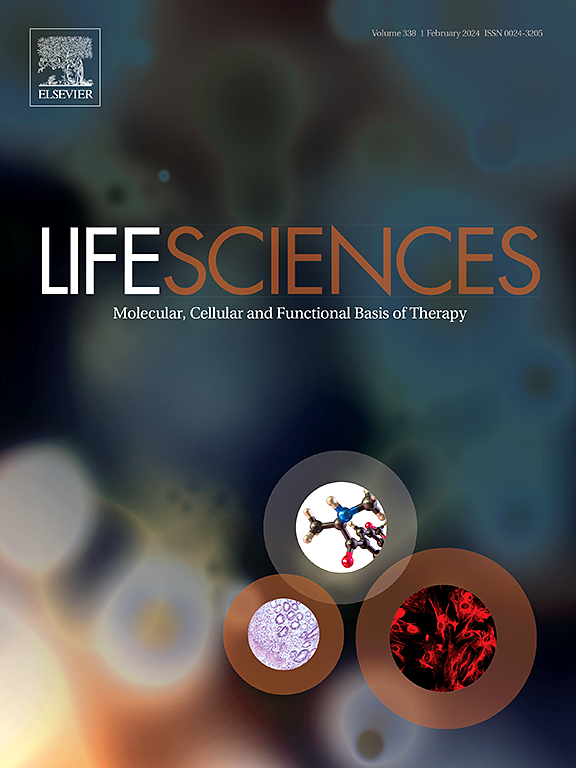Gamma-aminobutyric acid-mediated neuro-immune interactions in glioblastoma: Implications for prognosis and immunotherapy response
IF 5.2
2区 医学
Q1 MEDICINE, RESEARCH & EXPERIMENTAL
引用次数: 0
Abstract
Aims
This study aimed to investigate the role of gamma-aminobutyric acid (GABA) in the glioblastoma (GBM) tumor immune microenvironment (TIME) and its impact on prognosis and response to immunotherapy.
Main methods
This study employed single-cell RNA sequencing (scRNA-seq) to delineate the TIME of GBM, utilized non-negative matrix factorization (NMF) for GABA-associated cell clustering, and performed pseudotime analysis for cellular trajectories. Additionally, we integrated immunohistochemistry (IHC), immunofluorescence (IF), and protein-protein interaction (PPI) analysis to explore the regulatory mechanisms within the tumor microenvironment.
Key findings
The study identified distinct GABA-associated immune cell subtypes, particularly macrophages and T-cells, with unique gene expression and developmental trajectories. The development of the GABA-associated scoring model (GABAAS), introduced novel prognostic indicators, enhancing our ability to predict patient outcomes. This study also suggests that GABA-related genes, including NDRG2 and TIMP1, play a crucial role in immune modulation, with potential implications for immunotherapy responsiveness.
Significance
The findings underscore the potential of targeting GABA-related genes (NDRG2 and TIMP1) and M2 macrophage to reshape the glioblastoma immune landscape, offering a new frontier in personalized neuro-immunotherapy. This approach holds promise to counter individual tumor immunosuppressive mechanisms, enhancing patient outcomes.
胶质母细胞瘤中γ-氨基丁酸介导的神经-免疫相互作用:对预后和免疫疗法反应的影响。
目的:本研究旨在探讨γ-氨基丁酸(GABA)在胶质母细胞瘤(GBM)肿瘤免疫微环境(TIME)中的作用及其对预后和免疫治疗反应的影响:本研究采用单细胞RNA测序(scRNA-seq)来划分GBM的TIME,利用非负矩阵因式分解(NMF)对GABA相关细胞进行聚类,并对细胞轨迹进行伪时间分析。此外,我们还整合了免疫组化(IHC)、免疫荧光(IF)和蛋白-蛋白相互作用(PPI)分析,以探索肿瘤微环境的调控机制:研究发现了不同的GABA相关免疫细胞亚型,尤其是巨噬细胞和T细胞,它们具有独特的基因表达和发育轨迹。GABA相关评分模型(GABAAS)的开发引入了新的预后指标,提高了我们预测患者预后的能力。这项研究还表明,GABA相关基因(包括NDRG2和TIMP1)在免疫调节中发挥着关键作用,对免疫疗法的反应性具有潜在影响:研究结果强调了靶向GABA相关基因(NDRG2和TIMP1)和M2巨噬细胞重塑胶质母细胞瘤免疫格局的潜力,为个性化神经免疫疗法开辟了新领域。这种方法有望对抗个别肿瘤的免疫抑制机制,改善患者的预后。
本文章由计算机程序翻译,如有差异,请以英文原文为准。
求助全文
约1分钟内获得全文
求助全文
来源期刊

Life sciences
医学-药学
CiteScore
12.20
自引率
1.60%
发文量
841
审稿时长
6 months
期刊介绍:
Life Sciences is an international journal publishing articles that emphasize the molecular, cellular, and functional basis of therapy. The journal emphasizes the understanding of mechanism that is relevant to all aspects of human disease and translation to patients. All articles are rigorously reviewed.
The Journal favors publication of full-length papers where modern scientific technologies are used to explain molecular, cellular and physiological mechanisms. Articles that merely report observations are rarely accepted. Recommendations from the Declaration of Helsinki or NIH guidelines for care and use of laboratory animals must be adhered to. Articles should be written at a level accessible to readers who are non-specialists in the topic of the article themselves, but who are interested in the research. The Journal welcomes reviews on topics of wide interest to investigators in the life sciences. We particularly encourage submission of brief, focused reviews containing high-quality artwork and require the use of mechanistic summary diagrams.
 求助内容:
求助内容: 应助结果提醒方式:
应助结果提醒方式:


